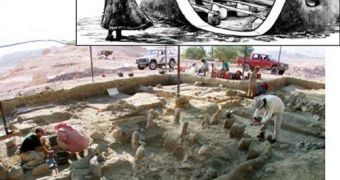Undoubtedly, the most defining moment for us as humans was when some of our ancestors decided to start domesticating wild animals, and settling down on a certain land. They started cultivating a relatively small variety of plants, but arguably what allowed them to remain put and survive in the then-inhospitable lands was the fact that they built storage rooms for the products they gathered from the fields, as in the first granaries.
Storing the crops relatively safe, out of the reach of animals and other rival clans, allowed for the development of communities. With a steady source of supply, the early groups could differentiate into several smaller ones, and trades could emerge, as not everyone needed to go out hunting or gathering. Others could focus on tasks such as manufacturing goods for the group, so arts and crafts got a real boost when that happened. And, researchers say, it was all made possible by the first granaries.
It has been a known fact for quite some time now that the first such communities appeared in the Middle East. Now, archaeologists investigating sites in Jordan have managed to discover relics of such structures that are so old, that they pre-date the onset of the Agricultural Revolution.
The buildings were dated to be about 1,000 years older than the first domesticated type of cereals, ScienceNow reports. The first plants were domesticated some 10,500 years ago, in the Near East. Researchers believe that, before that time, thousands of years were spent cultivating wild plants, without any changes in the people's lifestyles.
At the Gilgal 1 investigation site, near the West Bank, the dig teams discovered 300,000 grains of wild barley and 120,000 grains of wild oats, all inside a stone structure that proved to be about 11,400 years old. Throughout countries such as Jordan, Syria, Turkey and Israel, structures similar to the ones in the West bank were unveiled. In one instance, archaeologists discovered an entire village, in which structures some three meters in diameter, with their floors suspended from the ground, were believed to have been granaries.
The team that made the recent finds published the results of the investigation in this week's issue of the respected scientific journal Proceedings of the National Academy of Sciences. Experts now believe that the emergence of domesticated cereals, the growth of large communities, and the rise of social hierarchies were all favored by simple innovations, such as errecting the floor of a building off the ground, so as to keep rodents away and allow for air flow to keep the stored crops dry.

 14 DAY TRIAL //
14 DAY TRIAL //